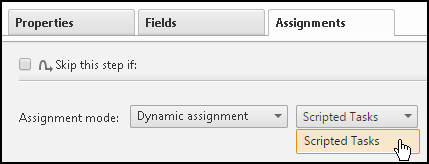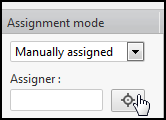On this page
Configuring Dynamic Assignment Custom Script for Rule Modification
|
|
This topic is intended for SecureChange workflow owners, who are responsible for creating and maintaining workflows. |
Overview
For dynamic assignment scenarios in a Rule Modification workflow, use a custom script to define the conditions of the dynamic assignment.
The script receives the ticket ID from SecureChange. In the script you can:
- Run REST API calls to SecureChange to gather information
- Gather information from external systems
- Process the gathered information to define the necessary tasks
- Define the assignment mode for each task, which can be either:
- self (Self-assignment) - The task is shown for all participants, and any participant can accept the task to be the handler.
- manual (Manually assigned) - The assigner specified for the task assigns the task to a specific handler. This mode requires the
assigner_usernamefield.
The script must return to SecureChange an XML formatted list of the tasks to create for the step and the assignment mode for each task in the format:
<tasks>
<task>
<name>...</name>
<participants>
<participant_username>...</participant_username>
<participant_username>...</participant_username>
</participants>
<assignment>
<assignment_mode>...</assignment_mode>
</assignment>
</task>
</tasks>
OR
<tasks>
<task>
<name>...</name>
<participants>
<participant_username>...</participant_username>
</participants>
<assignment>
<assignment_mode>...</assignment_mode>
</assignment>
</task>
<task>
<name>...</name>
<participants>
<participant_username>...</participant_username>
</participants>
<assignment>
<assignment_mode>...</assignment_mode>
<assigner_username>...</assigner_username>
</assignment>
</task>
</tasks>
Response URL Arguments
|
Name |
Description |
|---|---|
|
name |
The name of the task |
|
participant_username |
The name of a SecureChange user that is a participant for the task |
|
assignment_mode |
The assignment mode for the task, either: |
|
assigner_username |
(For manual assignment) The name of the SecureChange user that can assign the task to a handler |
Technical Notes
- The script must be accessible to the root user with read and execute permissions.
-
Errors:
- If the script does not return a response within 60 minutes, the step creates the default task as it is defined in dynamic assignment. An entry is added to the message board.
- If the script does not run or it fails for any reason, an entry is added to the message board.
- If there are schema validation errors, an entry is added to the audit trail.
Configure a Custom Script for Dynamic Assignment
-
In the assignment mode, select Dynamic assignment and Scripted Tasks.

-
Enter the full path to the script.

-
You can click Test to confirm that SecureChange can access the script with the correct permissions and that the script returns a properly formed XML response. Test calls the script with
testas the first and only argument. To pass the test, the XML response must be in the form of:<tasks></tasks>
-
Configure the default task:
-
Enter a unique Task Name.
-
Select participants for the task.
-
Select an Assignment mode:
-
Self-assigned: The task is shown for all participants, and any participant can accept the task to be the handler.
-
Auto-assigned: SecureChange assigns tasks to each participant in turn. You can select Prefer previous handler to automatically assign the task to the handler of the previous task.
-
Manually assigned: The assigner specified for the task assigns the task to a specific handler. Then, click
 to browse and select a SecureChange user to be the designated assigner for this task. This assigner will receive a task of assigning the task for this step to a step participant:
to browse and select a SecureChange user to be the designated assigner for this task. This assigner will receive a task of assigning the task for this step to a step participant:
-
-
-
Click Save.
How Do I Get Here?
SecureChange > ![]() Workflows
Workflows
Was this helpful?
Thank you!
We’d love your feedback
We really appreciate your feedback
Send this page to a colleague